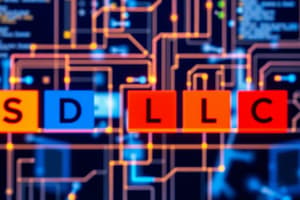Podcast
Questions and Answers
What is the main goal of Information Systems Analysis and Design (SAD)?
What is the main goal of Information Systems Analysis and Design (SAD)?
To improve employee efficiency by applying software solutions to key business tasks.
Who performs Systems Analysis and Design (SAD) based upon their understanding of the organization's objectives, structure, and processes?
Who performs Systems Analysis and Design (SAD) based upon their understanding of the organization's objectives, structure, and processes?
Systems Analysts.
What is the role of computer-aided software engineering (CASE) tools in Systems Development?
What is the role of computer-aided software engineering (CASE) tools in Systems Development?
To assist in the development of information systems.
What are the components of a system according to the text?
What are the components of a system according to the text?
How does a system turn data into information?
How does a system turn data into information?
What separates a system from its environment?
What separates a system from its environment?
List three characteristics of a system as mentioned in the text.
List three characteristics of a system as mentioned in the text.
What is the major goal of systems analysis and design according to the text?
What is the major goal of systems analysis and design according to the text?
What do controls associated with a system aim to prevent?
What do controls associated with a system aim to prevent?
Define decomposition in the context of system analysis?
Define decomposition in the context of system analysis?
What is the significance of modularity in system design?
What is the significance of modularity in system design?
Explain the concept of coupling in system design?
Explain the concept of coupling in system design?
What does cohesion measure in the context of system analysis?
What does cohesion measure in the context of system analysis?
How does systems integration benefit organizations?
How does systems integration benefit organizations?
Why is it important to have high cohesion in subsystems?
Why is it important to have high cohesion in subsystems?
What are the two main activities involved in Systems Planning and Selection phase?
What are the two main activities involved in Systems Planning and Selection phase?
What is the purpose of Systems Analysis phase?
What is the purpose of Systems Analysis phase?
What are the two main components of System Design phase?
What are the two main components of System Design phase?
What are the activities involved in System Implementation, Operation, and Maintenance phase?
What are the activities involved in System Implementation, Operation, and Maintenance phase?
What is the role of SA (Systems Analyst) in Systems Development?
What is the role of SA (Systems Analyst) in Systems Development?
What does the Systems Development Life Cycle (SDLC) involve?
What does the Systems Development Life Cycle (SDLC) involve?
What are the advantages of prototyping in system development?
What are the advantages of prototyping in system development?
What are the disadvantages of prototyping in system development?
What are the disadvantages of prototyping in system development?
What is Joint Application Design (JAD) in system development?
What is Joint Application Design (JAD) in system development?
What is Rapid Application Development (RAD) and how does it utilize prototyping?
What is Rapid Application Development (RAD) and how does it utilize prototyping?
Name some Agile Methodologies mentioned in the text.
Name some Agile Methodologies mentioned in the text.
What is the focus of Agile Methodologies in system development?
What is the focus of Agile Methodologies in system development?
Study Notes
- Information Systems Analysis and Design (SAD) is a structured method used to create and maintain systems that improve employee efficiency by applying software solutions to key business tasks.
- Systems Analysts perform SAD by understanding an organization's objectives, structure, processes, and leveraging information technology for an advantage.
- The core goal of Systems Analysis and Design is to enhance organizational systems by developing or acquiring application software, providing training, hardware, system software, documentation, job roles, controls, and interfaces.
- A system is an interrelated set of business procedures within a business unit that turns data into information, with components like purpose, environment, boundary, interrelationships, constraints, interfaces, input, and output.
- Important system concepts include decomposition (breaking down a system into smaller components), modularity (dividing a system into modules), coupling (desired loose coupling between subsystems), and cohesion (high cohesion where subsystems perform a single function).
- Systems Integration enables hardware and software from different vendors to work together, using a visual programming environment with a client/server model.
- The Systems Development Life Cycle (SDLC) involves phases like systems planning and selection, systems analysis, system design, and system implementation, operation, and maintenance; alternative approaches include prototyping, Joint Application Design (JAD), Rapid Application Development (RAD), and Agile Methodologies.
Studying That Suits You
Use AI to generate personalized quizzes and flashcards to suit your learning preferences.
Description
Test your knowledge on information systems analysis and design, the systems analyst role, SDLC, and computer aided software engineering (CASE). This quiz covers key concepts from Chapter 1 of 'Essentials of Systems Analysis and Design Fifth Edition' by Valacich, George, and Hoffer.



